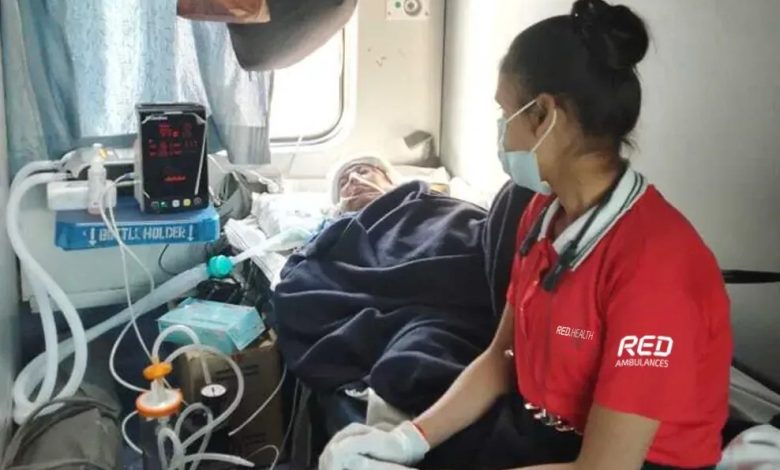The Evolution of Train Ambulances in India: From Concept to Implementation

India has always been a land of innovation, especially when it comes to healthcare. One of the most recent and impactful innovations in the country has been the development of train ambulances. These specialized trains have transformed the way medical emergencies are handled, offering a vital service for transporting critically ill patients across long distances. The journey of the train ambulance service in India from a mere concept to full-fledged implementation is a story of dedication, resourcefulness, and the drive to save lives.
The Birth of the Train Ambulance Concept
The idea of a train ambulance was born out of necessity. India is a vast country with a diverse landscape, ranging from mountains to plains and from cities to remote villages. The sheer vastness and diversity of the country present substantial challenges to the healthcare system. Road ambulances, while effective, have limitations, particularly when it comes to traveling great miles or reaching rural places fast. Air ambulances, on the other hand, are costly and only sometimes feasible.
This is where the concept of a train ambulance comes into play. Trains have always been a lifeline for India, connecting even the most remote areas with significant cities. The idea was to leverage the country’s extensive railway network to create a reliable and cost-effective means of transporting patients over long distances. The concept was simple: convert a train coach into a mobile hospital equipped with all necessary medical facilities, allowing for continuous medical care during the journey.
The Initial Challenges
Implementing the train ambulance service in India was challenging. The first hurdle was modifying train coaches to accommodate medical equipment and ensure a stable environment for patients. Train coaches had to be redesigned to include hospital beds, life support systems, and medical equipment. Additionally, the coaches needed to be fitted with power backups to ensure that medical devices remained operational throughout the journey.
Another challenge was staffing these ambulances with trained medical professionals. Unlike road ambulances, where paramedics and doctors can easily be rotated, train ambulances require a dedicated team that can stay with the patient for the entire journey, which could last several hours or even days.
Lastly, coordination between the railways and healthcare providers was essential. The train ambulance service needed to be seamlessly integrated into the existing railway schedule while ensuring that patients received timely care.
The First Steps Towards Implementation
Despite the challenges, the first train ambulance service in India was successfully launched. The initial services were aimed at transporting critically ill patients from smaller towns to major cities where they could receive advanced medical care. These early train ambulance services proved to be a game-changer, especially for patients in remote areas who needed to travel long distances for treatment.
One key factor behind the success of these early services was the introduction of online ambulance booking. This system allowed patients and their families to book a train ambulance quickly and efficiently, ensuring that help was available when needed most. The online ambulance booking system also streamlined the process of coordinating between hospitals, railways, and ambulance services, reducing delays and improving patient outcomes.
Expansion and Growth
As the success of the initial train ambulance service in India became evident, the concept began to gain traction. The Indian government, along with private healthcare providers, started investing in the expansion of this service. More trains were converted into ambulances, and the network of train ambulances began to grow, covering more routes and reaching more people.
The expansion also saw improvements in the services offered. Newer train ambulances were equipped with advanced medical equipment, including ventilators, defibrillators, and monitoring systems. This ensured that patients could receive the same level of care they would in a hospital, even while travelling hundreds of kilometres.
The train ambulance service also started offering specialized care for different types of patients. For example, some trains were equipped with neonatal care units for transporting newborns, while others were designed for patients requiring cardiac care. This level of specialization has made train ambulance services in India an essential part of the healthcare system.
Impact on Healthcare in India
The introduction of train ambulance services has had a profound impact on healthcare in India. For starters, it has greatly increased access to medical treatment in remote and neglected places.Patients who would have previously struggled to reach a hospital can now be transferred promptly and safely to a facility where they can receive the necessary treatment.
Moreover, the train ambulance service has reduced the strain on road ambulances, especially in urban areas where traffic congestion can delay patient transport. By offering an alternative mode of transportation, train ambulances have helped decongest roads and ensure that road ambulances are available for shorter, more urgent trips.
The train ambulance service in India has also proven to be a cost-effective solution. Compared to air ambulances, train ambulances offer a much more affordable option for long-distance patient transport. This affordability has made advanced medical treatment available to a more significant portion of the population, saving innumerable lives in the process.
The Future of Train Ambulances in India
Looking ahead, the future of train ambulance service in India looks promising. Plans are underway to expand the network further, covering more routes and reaching even more remote areas. The government and private sector are also exploring ways to enhance the services offered, such as incorporating telemedicine facilities to provide real-time consultations with specialists during the journey.
Also, efforts are being made to enhance awareness about the availability of rail ambulance services. Many people still need to learn that this option exists, and increasing public awareness will ensure that more patients can benefit from these services. The online ambulance booking system will play a crucial role in this, making it easier for people to access train ambulances when they need them.
Conclusion
The evolution of train ambulances in India is a testament to the country’s ability to innovate and adapt to the unique challenges of providing healthcare in a vast and diverse landscape. From a concept born out of necessity to a fully operational service that has saved countless lives, the train ambulance service in India has proven to be an invaluable addition to the nation’s healthcare system.
As the service increases and improves, it will most certainly play an even more essential role in ensuring that all Indians, regardless of where they live, have access to the medical services they require. For those looking to learn more or to access these vital services, connect with RED. As, they help with online ambulance booking and a commitment to providing the best possible care during critical moments.





